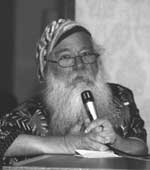
NEADS Conference 2004 - Right On!
Speakers
Jim Derksen

|
Biography
Jim Derksen was born in 1947 in Morris, a small farming community in Manitoba. He was disabled during the polio epidemic on 1953 and has used a wheelchair for personal mobility since that time. He has participated in the founding and served as president of the Council of Canadians with Disabilities (formerly COPOH), the Canadian Disability Rights Council (CDRC) and several other disability rights self-representational advocacy organizations. He has also had several Privy Council and Ministerial appointments to advisory and regulatory offices. Jim is the past-Chair of the CCD’s Human Rights Committee.
Jim Derksen lives in Winnipeg where he works as a consultant in Manitoba. He is a single father of a 16 year old daughter.
Summary
NEADS conference chair Jason Mitschele introduced Jim Derksen at the Saturday evening banquet.
Derksen was born in 1947 in Morris, a small farming community in Manitoba. He began using a wheelchair after being disabled during the polio epidemic of 1953. Since that time, Derksen has founded the Council of Canadians with Disabilities (CCD), the Canadian Disability Rights Council (CDRC), and several other disability rights self-representative advocacy organizations. He spoke about the history of the disability movement in Canada.
Derksen expressed his pleasure at being able to attend the conference and at seeing such a large group of young people with leadership qualities and potential. He said that he was impressed and encouraged by what he was seeing and by the quality of the speakers and the workshop agenda.
Derksen reflected on the fact that he has been involved with the disability movement for a long time—since 1972. He has a lot of stories to tell, and many experiences of being involved in strategic decisions that were made over the years.
Derksen said that, when he was born, people with disabilities were seen in a moral framework. It was understood that people with disabilities were relegated to the role of beggar. Throughout the world, including Canada, disabled people were seen as the deserving poor, with limited options in life. For example, individuals with certain disabilities became watch repairers; those with blindness worked on chairs or piano repair. Helping organizations at that time were charities. Many have evolved and still behave like charities. One of the important aspects of charities was that more of them were located in urban environments, and laws and institutions began to be created to warehouse people with disabilities. People with disabilities were considered morally inferior, and state charities tended to keep people in poverty in their place.
The second kind of framework was the medical framework. An idea evolved that people with disabilities were threats to the gene pool because they were biologically inferior. Having a disability reflected poorly on one’s family. Words such as “badly bred” and “not of good stock” were used to imply biological inferiority. The killing of people with disabilities was a general practice from coast to coast. Sterilization was also practiced. Often, individuals were not told that they had been sterilized.
Another aspect of the medical model was to “fix” what is “broken.” For example, people affected by polio were put into braces and told that they could walk again. The medical profession did not want to be reminded of its failures when expectations about results failed to come to fruition. One framework focuses financial resources on finding cures; another framework focuses on transforming society so that people with disabilities can function there.
In the late 1960s and early 1970s, as a result of the civil rights movement and women’s movement, the importance of the need to change language became clearer. Language needed to be changed so that issues could be seen in a different light. Examples are the phrases “black is beautiful” and “black power.”
Language change underscored the radical notion that the problem was not with individuals, but with the way in which society perceived them. People began to become aware that because the social environment was constructed by humans, it could also be deconstructed. It was not immutable; it could be tested and criticized. Thus, in the 1970s, human rights codes began to emerge. Nova Scotia was the first province to encode a right not to be discriminated against in employment services or in the provision of goods and services. No such thing as accommodation yet existed.
Derksen next gave several examples of human rights case law involving people with disabilities. He noted the importance of human rights protection and the need to take complaints to the Human Rights Commission. The problem is that cases are settled individually there, and so the system doesn’t change.
In 1980, the Coalition of Provincial Organizations of the Handicapped -- now called the Council of Canadians With Disabilities -- was formed. Strength in numbers derived from the recognition that joining together in common bonds of understanding and experience, rather than remaining separated by differences. Subsequently the group could have a stronger influence on public policy. As a result, in 1980–1981, the Parliament of Canada introduced the Obstacles Report, with 130 recommendations for changing infrastructure such as transportation and communications to enable better integration of people with disabilities into society. That report was a major historical turning point.
At the same time, a decision was taken to form national and international groups to counter the difficulties that had been experienced in organizing local and provincial groups. As a result, organizers were able to influence the content of the World Program of Action, and the standardization of equal opportunity. Work at the national and international levels furthered the work “on the ground.”
Considerable energy was also put into providing input to the Charter of Rights and Freedoms. Derksen was seconded to Parliament to serve as an advisor for the Obstacles Report. A formal recommendation was made to embed the Charter of Rights and Freedoms into the Canadian constitution. Derksen talked about how his group used certain tactics such as following committee members to the washrooms, and sitting behind parliamentarians on the committee “day after day after day.”
Derksen provided several case examples of Supreme Court decisions on equality rights. In one situation, he and his colleagues formed an alliance with an organization representing women’s legal rights: LEAF. Together, they were able to persuade the Supreme Court to take an approach designed to protect groups that are persistently vulnerable to discrimination. Another case involved the right of a deaf married couple to interpreter services during the birth of their twin children in a hospital in British Columbia.
Derksen also mentioned the Latimer case, in which, in the face of contrary public opinion, the court recognized the need for equal protection under the law and the value of an appropriate sentence for the murder of a child with a disability.
Derksen pointed out the important work that Steve Estey is doing with the new United Nations (UN) Convention to protect and promote the rights and dignity of people with disabilities. He challenged the conference delegates to actively work to move that convention into the system and to achieve ratification. The vertical and horizontal strategies for activism that were used 20 years ago still apply to the new convention and to what happens in Canada—despite the existence of the Charter and the Code. Derksen said that CCD is very interested in this project. The UN convention is bringing to light dreadful situations that exist in institutions for disabled people around the world. Bringing those situations to light is very important.